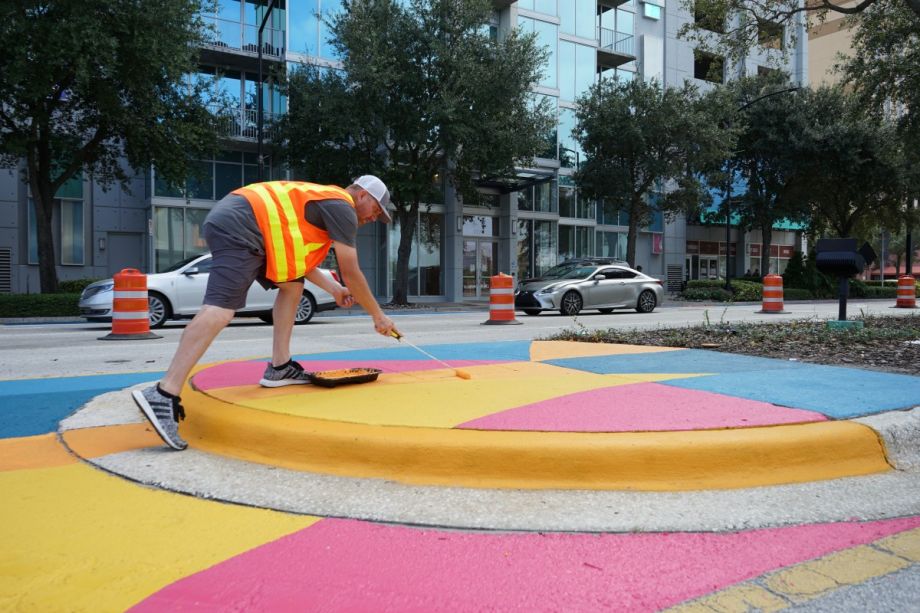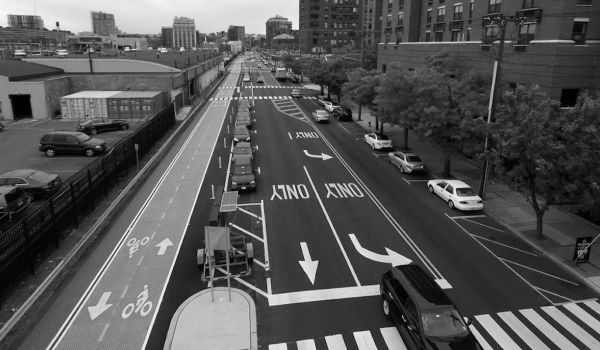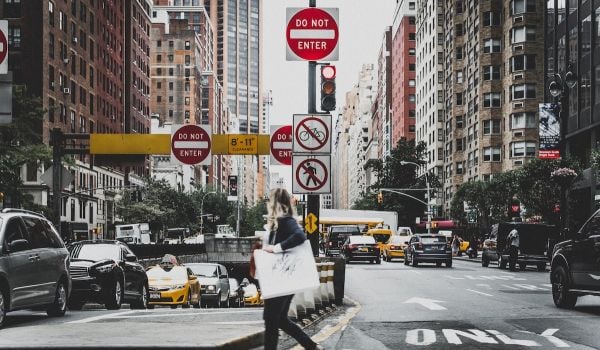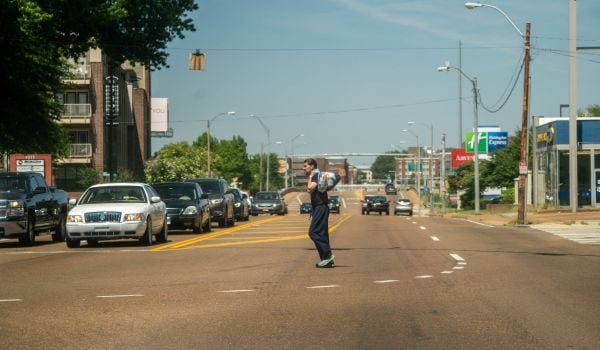The Tampa metro area is near the top among American cities for pedestrian and cyclist deaths and injuries. The issue is of concern to politicians, planners, Vision Zero advocates, and the public. A lack of funding to make the necessary infrastructure changes to reduce the number of casualties in Hillsborough County is being remedied by low-cost quick fixes. With over 3,000 miles of roads in the county, many of them without sidewalks nor crosswalks, large investments to redesign its car-centric streets into more pedestrian and cyclist-friendly thoroughfares are needed. In the City of Tampa, one of those inexpensive alternatives is painting attention-getting murals on intersections and crosswalks.
The large investments in redesigning the county’s roads were expected to be funded by All for Transportation, a 1 percent increase in the sales tax for 30 years, approved by voters in 2018. But the tax was almost immediately challenged by lawsuits (including one by one of Hillsborough County’s elected commissioners); until the lawsuits are resolved, the almost $300 million collected so far cannot be used by the county nor dispersed to any of the cities within its jurisdiction.
With a decision pending any day now, how critical is AFT to Tampa’s future transportation needs? Stephen Benson, the Chief Planner for the City of Tampa, says the city is doing more larger infrastructure projects, but without AFT, achieving those projects will take time.
“All For Transportation is extremely important, because we have a backlog of tens of millions of dollars of projects that we want to do,” stresses Benson. “It turns what is a 30-year plan into a 5 or 10-year plan. So we get it all done much quicker.”
In the meantime, Tampa is doing what it can on a limited budget. Since 2014, Tampa has had a program called ART in the Right of Way, also known as the Painted Intersection Program, which helps registered neighborhood associations choose which intersections should be painted. “The City established a process for individual neighborhoods to propose intersections in their areas and take the lead with hiring the artist and coordinating volunteers to do the painting,” explains Benson in an email. A separate program, Crosswalks to Classrooms, paints traffic-calming murals on crosswalks near schools.
This year, the City has continued painting more crosswalks and intersections, hoping to complete a dozen of each by the end of 2020. The pandemic has meant less vehicles on the streets, which in turn have made it easier to close major thoroughfares for painting with little disruption to traffic. Most notable is the six block-mural painted on North Ashley Drive in Downtown Tampa, completed in September.
“We did the Ashley Drive mural with the artist [Meaghan Farrell Scalise], city of Tampa staff, Tampa Downtown Partnership staff, and a few friends and family,” says Karen Kress, the director of transportation and planning for the Tampa Downtown Partnership, the business improvement entity in that part of the city. “This all falls under the Paint Saves Lives national campaign. We looked at what New York City did with its low-cost tactical urbanism projects. They used the three Ps: paint, planters, and posts. Obviously, it’s very expensive to do concrete buildouts, but on the Ashley Drive project we used paint, posts and decorative planters to define space,” she says.
Kress lists four reasons that Ashley Drive was the perfect location for a road mural of this scale. First, it’s in a prime location in downtown Tampa, cutting through a busy area separating a waterfront park from the central business district. The other three reasons have to do with driver behavior. “Ashley Drive is an off ramp of Interstate 275. We wanted to give drivers visual cues that they’re entering a vibrant neighborhood and have to slow down, and it’s been very well received,” says Kress. “We did outreach to the adjacent properties to make sure that they understood what the goal was. We often had illegal parking, so we put murals anywhere cars were not supposed to be along the corridor. During Covid, we’ve unfortunately had some drag racing along Ashley Drive, and that was another impetus for doing this.”
Ashley Drive is the first location for the city’s latest pilot program, meant to use color and texture to create painted curb extensions. “Flexible posts will be added to Ashley Drive to reinforce the ‘narrower’ road space,” Benson says. “The ‘life span’ of the art will be long enough to measure and study the impact/performance.”
Most of the road murals are funded by external partners. The Ashley Drive mural cost $30,000, but was funded by the Tampa Downtown Partnership. “The cost included the artist design fees, the paint, planters, posts, but the only thing we didn’t pay for was the City of Tampa staff time to set up cones to control traffic and to install the posts,” Kress explains. “We also asked the city to refresh the crosswalks so it all looks brand new. In terms of a transportation project, $30,000 is not that much.”
These murals are easy fixes, which Benson notes are popular among the public and the media.
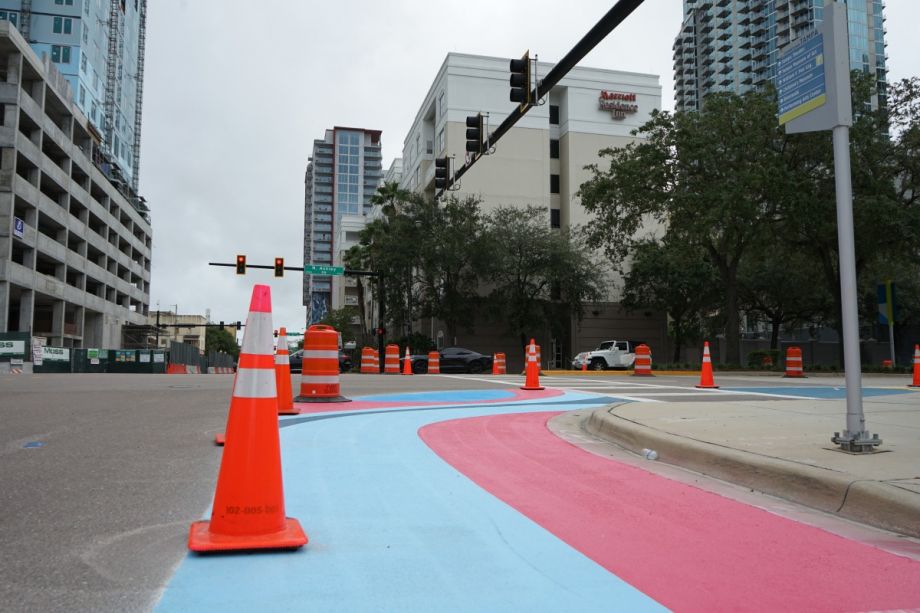
(Photo courtesy Tampa Downtown Partnership)
But are they effective? Once the novelty is gone and drivers get used to them, will traffic go back to previous speeds? Both Benson and Kress hope that research on this topic is completed sometime in 2021.
“The reaction has been strong anecdotally, but we need to do data collection to prove the case that it is slowing down traffic,” admits Kress. “It’s just been completed, so we don’t have a plan in place for that data collection to quantitatively measure whether it has been successful, but we are working towards that.”
Emily Hinsdale, President and Co-founder of Sidewalk Stompers, Inc., a group whose mission is to improve student health and safety by increasing the number of student pedestrians, has observed the challenges facing the city for years. “Tampa has grown very rapidly in the last 10 to 20 years. Infrastructure takes a long time to catch up to that population growth,” she says. “It is a city that is largely designed around cars, and it is getting slowly to the point where it is starting to really invest in walking and biking infrastructure.”
Persuading county residents to leave their cars at home is difficult without better mass transit. “That is a huge concern for a lot of people here who would like alternative forms of mobility,” Hinsdale says. “It is something that the city and the county are working on, but it’s a long climb.”
She likes the idea of road murals as a first step in changing the conversations around the future of city streets, and the fact that it is something that can be done immediately with little cost. “Paint is cheap, but can also be very effective,” says Hinsdale. “Paint Saves Lives turns a street from being a black-top thoroughfare into community space. So that when you are driving down the road, you are not only seeing the road, but that this is an active space, that is pretty, and worth looking at. This is part of your city, you are a part of it, and not separated from it by your car.”
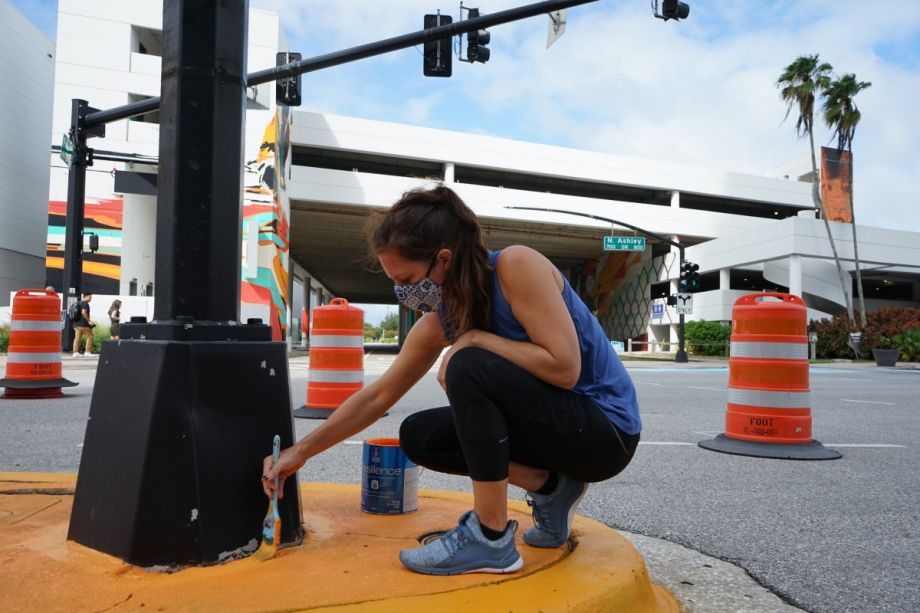
(Photo courtesy Tampa Downtown Partnership)
Hinsdale hears how positive the public reaction has been to the murals, but also hears the complaints. Though for her, even the complaints from drivers are a positive sign. “When they are complaining about it, there is going to have to be some acknowledgement on their part that what they are saying is that they need to speed,” she says. “On North Ashley Drive, the paint narrows the lanes, but it also creates a pedestrian refuge. People are able to be in a protected space further out into the roadway and are more visible to cars as they approach crossings.”
She believes that the Crosswalks to Classrooms program was necessary because of traffic conditions around city schools. Some of them are on streets where the arrival and dismissal zones do not consider how children might walk or bike to school, instead of being driven. “If you have an elementary school on a minor road with 500 cars pulling in to drop their kids off, suddenly it’s not a minor road anymore at that time of day,” Hinsdale says. “Police will come out to different schools and different times, but enforcement is not a very effective long-term solution. Road design is the safest way to change how people drive.”
Public officials and Vision Zero advocates have three things in common. Both have a desire to see safer streets in Hillsborough County, and the City of Tampa especially. Both see road murals as an important first step in getting there, increasing safety instantaneously while changing the conversation around streets. They also both agree that without the proper funding, traffic safety may end at this first step.
“The planning is not the problem, it’s always the funding source,”says Stephen Benson. “But even without that funding source, we will still work to achieve zero deaths and injuries. With that funding source, you would expect to see large scale transformative projects. Without the funding source, expect to see more of the low-cost projects.”

